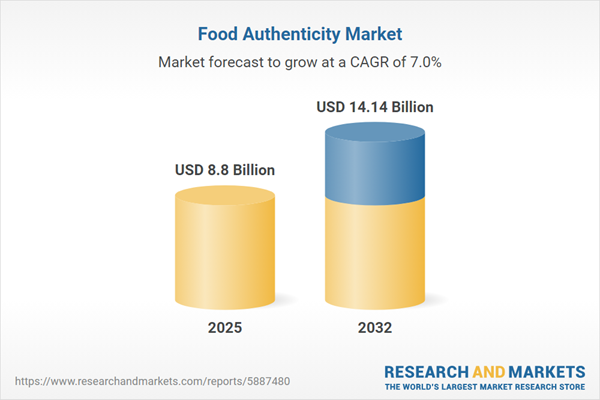Speak directly to the analyst to clarify any post sales queries you may have.
Senior decision-makers face heightened pressure to ensure food authenticity as supply chains become more complex and regulations more stringent. Advanced verification technologies and targeted strategies are now critical for maintaining compliance, safeguarding brand reputation, and strengthening procurement operations.
Market Snapshot: Food Authenticity Market Growth and Trends
The food authenticity market is set for considerable growth, with the market value forecast to increase from USD 8.24 billion in 2024 to USD 14.14 billion by 2032. This rise reflects a robust CAGR of 6.98%. Key market drivers include tighter regulatory enforcement, growing consumer expectations for accurate product labeling, and an increased focus on transparent ingredient traceability. Organizations are actively investing in real-time verification solutions and adaptive compliance frameworks to address the risk of food fraud. Enhanced supply chain mapping and the integration of analytical tools allow for more effective management of complex procurement networks and the ongoing fulfillment of quality standards.
Scope & Segmentation: Food Authenticity Market
- Test Types: Chromatography, DNA-based methods, immunoassays, and advanced spectroscopy serve as the foundation of ingredient integrity verification, expediting irregularity detection across the food industry.
- Product Categories: Consumables including enzyme kits and reagents, laboratory instruments, specialized analytics software, and professional services together underpin streamlined verification and quality control.
- Applications: Ingredient verification, contaminant identification, organic certification, and origin tracking directly support regulatory compliance efforts, heighten process quality, and drive efficient procurement activities.
- End Users: Major users include food and beverage manufacturers, research institutes, government agencies, standards bodies, and third-party laboratories who depend on integrated solutions to ensure compliance and operational visibility.
- Regional Reach: The market spans North America, Latin America, Europe, the Middle East, Africa, and Asia-Pacific. Unique regulations, infrastructure diversity, and variable procurement needs in each region drive the requirement for specialized strategies.
- Key Market Players: Major industry participants such as Eurofins Scientific SE, SGS SA, Bureau Veritas S.A., Intertek Group plc, ALS Limited, Mérieux NutriSciences Corporation, LGC Group Limited, NSF International, Underwriters Laboratories LLC, and FoodChain ID, Inc. drive innovation and cross-border adoption of advanced verification solutions.
Key Takeaways for Senior Decision-Makers
- Employing DNA-based testing and immunoassays supports comprehensive supply chain transparency and enhances traceability from sourcing to finished product.
- Introducing automation and AI-enabled analytics allows companies to swiftly identify and resolve quality issues, improving operational response and resilience.
- Modernizing quality management systems ensures alignment with changing regulations, making audit processes more efficient and lowering compliance risk.
- Collaboration among industry and procurement stakeholders standardizes verification and allows prompt adaptation to regulatory or market shifts.
- Leveraging on-site validation technologies offers flexibility for real-time compliance management and readiness for international market requirements.
- Linking sustainability and responsible sourcing practices with authenticity efforts can enhance stakeholder trust and contribute to long-term strategic value.
Impact of United States Tariff Measures
Changes in U.S. tariff policies are prompting companies to reassess procurement approaches and supplier relationships. Primary responses include expanding domestic sourcing, prioritizing closer links with local suppliers, and focusing on strict cost control. These methods contribute to greater supply chain reliability, lower risk from policy fluctuations, and better operational stability in a changing market landscape.
Food Authenticity Market: Methodology & Data Sources
This analysis draws from interviews with laboratory managers, regulatory authorities, and industry experts. All insights are supported by peer-reviewed research and leading data repositories, offering a credible resource for informed executive decision-making.
Why This Report Matters
- Delivers actionable insights to improve compliance, reduce risk, and prioritize effective technology investments in the food authenticity market.
- Supports strategic planning and optimal resource allocation by geography and business need, allowing leaders to respond to evolving industry challenges.
- Promotes transparent, trustworthy supply chains that strengthen stakeholder confidence and safeguard business reputation in procurement processes.
Conclusion
Strategic investment in robust verification and compliance frameworks equips organizations to manage regulatory changes efficiently while protecting brand value. Food authenticity strategies designed for adaptability provide assurance and long-term resilience for senior leadership.
Additional Product Information:
- Purchase of this report includes 1 year online access with quarterly updates.
- This report can be updated on request. Please contact our Customer Experience team using the Ask a Question widget on our website.
Table of Contents
3. Executive Summary
4. Market Overview
7. Cumulative Impact of Artificial Intelligence 2025
Companies Mentioned
The companies profiled in this Food Authenticity market report include:- Eurofins Scientific SE
- SGS SA
- Bureau Veritas S.A.
- Intertek Group PLC
- ALS Limited
- Mérieux NutriSciences Corporation
- LGC Group Limited
- NSF International
- Underwriters Laboratories LLC
- FoodChain ID, Inc.
Table Information
| Report Attribute | Details |
|---|---|
| No. of Pages | 181 |
| Published | November 2025 |
| Forecast Period | 2025 - 2032 |
| Estimated Market Value ( USD | $ 8.8 Billion |
| Forecasted Market Value ( USD | $ 14.14 Billion |
| Compound Annual Growth Rate | 6.9% |
| Regions Covered | Global |
| No. of Companies Mentioned | 11 |









